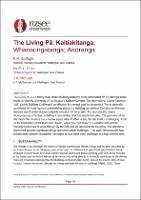| dc.contributor.author | Ballagh, Rowan | |
| dc.contributor.author | Maclean, James | |
| dc.contributor.author | Chin, Eng Liang | |
| dc.date.accessioned | 2024-07-01T02:01:19Z | |
| dc.date.available | 2024-07-01T02:01:19Z | |
| dc.date.issued | 2024-04-09 | |
| dc.identifier.uri | https://repo.nzsee.org.nz/xmlui/handle/nzsee/2741 | |
| dc.description.abstract | The Living Pā is a 3-storey mass timber building currently being constructed for Te Herenga Waka Victoria University at their Kelburn Campus. Full Living Building Challenge certification is a central goal for the project. This is generally considered the most rigorous sustainability standard a building can achieve. Compliance with this standard significantly dictates materials selection for the project. For structure this means widespread use of timber, including a mass timber structure and timber piles. Further to this, the site itself is challenging. It sits on the headwaters of the Kumutoto Stream, which has contributed to a variable rock profile. Varying thicknesses of weak fill overlay the rock and are unsuitable for founding. The geometry of the site means the structure has a high aspect ratio. The ambitious client brief presents significant design and construction challenges. This paper demonstrates how collaboration between disciplines has helped to overcome these challenges in a high seismic zone | |
| dc.language.iso | en | |
| dc.publisher | New Zealand Society for Earthquake Engineering | |
| dc.relation.ispartofseries | 2024;66 | |
| dc.subject | Seismic performance, risk mitigation and resilience of new and existing structures | |
| dc.title | Te Living Pā: Kaitiakitanga; Whanaungatanga; Akoranga | |
| dc.type | Article | |

